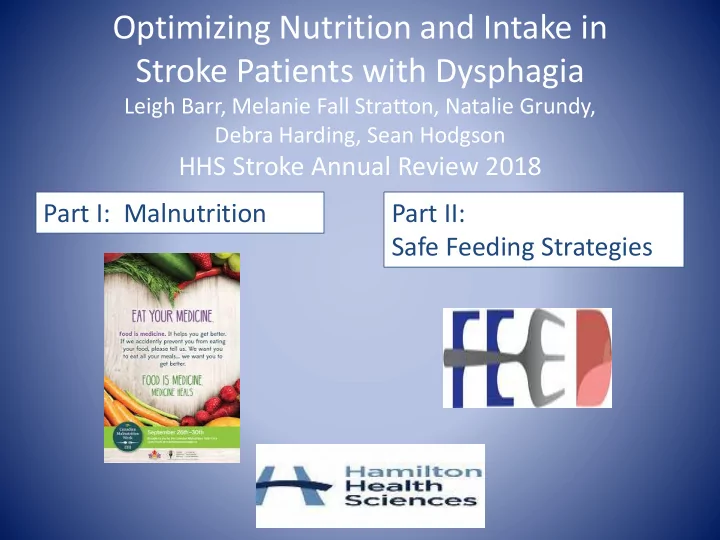

Optimizing Nutrition and Intake in Stroke Patients with Dysphagia Leigh Barr, Melanie Fall Stratton, Natalie Grundy, Debra Harding, Sean Hodgson HHS Stroke Annual Review 2018 Part I: Malnutrition Part II: Safe Feeding Strategies
Part I: Malnutrition
Nutrition
Question # 1 Do Dietitians and Dietetic Assistants assess all stroke patients?
Answer #1 • We screen patients to triage them into high, moderate or low nutrition risk categories. • This triaging drives whether we complete a detailed assessment of a patient and how often we see them. • We assess most high risk pts, some moderate risk pts and rarely low risk pts.
Question #2 What percentage of adults are malnourished upon admission to hospital?
Answer #2 45% 45% Malnourished patients have an increased length of stay. Malnourished patients can be identified by asking 2 questions: 1. Have you lost weight in the past 6 months without trying to lose this weight? 2. Have you been eating less than usual for more than a week? If the patient answers yes to both of these questions, they are at risk for malnutrition.
Question #3 What barriers exist in hospital that prevent adequate food intake?
Answer # 3 1. Poor appetite (64%) 2. Too sick (43%) 3. Tired (41%) 4. Pain (37%) 5. Difficulty opening food packages (30%) 6. Uncomfortable position to eat (27%) 7. Difficulty reaching food (20%) 8. Not given replacement tray when meals missed (70%) 9. Did not want food that was ordered (58%) 10. Did not get help when needed (42%)
Question # 4 What are the consequences of malnutrition?
Answer #4 Malnutrition can lead to: increased length of stay/hospital costs increased complications decreased wound healing Increased infections increased falls increased readmissions
Question #5 Why is the Supplemental Nutrition Program (SNAP) Important?
Answer # 5 Patients are willing to take with medications and it provides 500 kcal and 20 g protein. This could make the difference of avoiding the insertion of a feeding tube!
Weight Measurements… are key to screening and monitoring nutritional status!
Part II: Safe Feeding Strategies The slides used in this presentation are based on the FEED (Facilitating Effective Eating in Dysphagia) program used at St. Peter’s Hospital, previously known as safe feeding training.
Impact of Dysphagia Dysphagia can be a chronic condition requiring lifelong management: Linked to higher mortality Medical complications including pneumonia, pneumonitis Increases risk of choking Dependence for feeding is associated with increased risk for complications such as aspiration pneumonia, choking, malnutrition and dehydration. (Langmore, Terpenning, Schork et al., 1998).
Standard Procedure 1- Feeding Recommendations GOAL : Provide the key information required to feed an individual in the safest and most effective way. Before any oral intake of food or fluids, read all feeding recommendations and use appropriate practice.
Feeding Guidelines Make reference to: Swallowing Guidelines: Patient name- Prince Harry “Pink” sheets above bed 1. Nectar thick fluids Kardex slips 2. Minced plus 3. Water via teaspoon between meals Orders in chart 4. Medications to be taken whole with applesauce Meditech SLP dysphagia 5. Upright for all P.O. and for 15-30 minutes post meals and follow-up note 6. Mouth care am & pm
Standard Procedure 2- Oral Intake and Position GOAL : Enhance a person’s ability to control the bolus. During all oral intake of food and fluids… Position trunk of the body is at ~ 90° angle at midline Ensure the head is positioned so the neck is slightly flexed
Standard Procedure 3- Food Check GOAL: Ensure that individuals receive only the food and fluid consistencies that can be safely swallowed. Before beginning to feed, check all food and fluids to confirm they meet dietary recommendations.
Standard Procedure 4- Feeder Position GOAL: Allow the person to maintain their position while promoting social interaction and allowing monitoring of the swallow. When feeding a person: Sit beside and slightly in front of them at an angle to allow for eye contact to be made at or slightly below the person’s eye level. If the person is in bed : Sit or stand and ensure eye contact is at the same level as the feeder.
Standard Procedure 5- Amount and Rate GOAL: Minimize the risk of aspiration. When feeding a person: give one level teaspoon of food or fluid for each swallow observe or physically feel the person’s swallow before introducing any more food or fluid • https://youtu.be/lIDJVgCkwW4?t=518
Standard Procedure 6- Clearing the Oral Cavity GOAL: Eliminate the possibility that the food residue in the mouth will end up in the person’s airway. Immediately following a meal, clear the oral cavity of any debris.
Oral Hygiene The thick secretions that plague so many dysphagic individuals are often a result of bacteria associated with infected teeth and gums. Daily oral hygiene procedures, along with regular treatments by dental-care professionals, will help to alleviate this condition. Who is at increased risk for aspiration pneumonia? • Frail elderly with their own teeth • Persons with caries and gum disease • Persons dependent on others for their mouth care
Standard Procedure 7- Post-Meal Position GOAL: Aid gastric emptying and avoid gastro- esophageal reflux material from reaching the person’s throat area where it can be aspirated. Position the person so they can remain comfortably upright for at least one hour after a meal. If the person is in bed, lower the head of bed slightly to no less than 60° from seating plane.
Standard Procedure 7 – Post-Meal Position
Standard Procedure 8- Documentation GOAL: Track gradual changes in status and communicate to other staff members who care for that person. Document any incidents, relevant observations, and the quantity of food and fluids taken (if less than half).
Case Study Review Discuss How does FEED link with the case study and why?
Final thoughts… SLP and Dietetics work closely together. We are a team within the team to help patients with dysphagia! Consult us often with specific details… QUESTIONS??
Recommend
More recommend